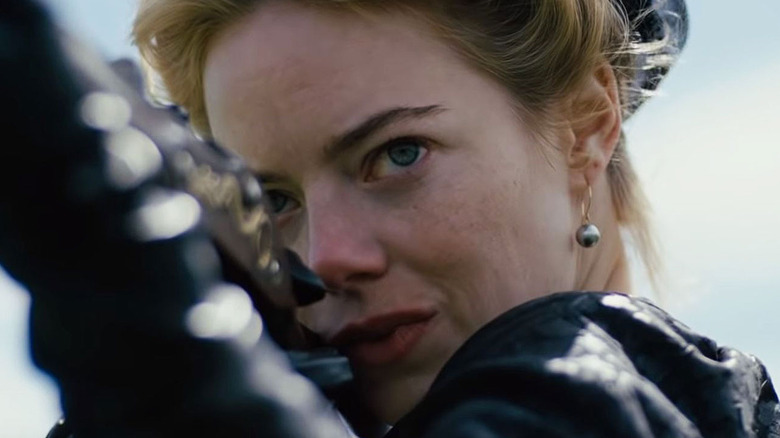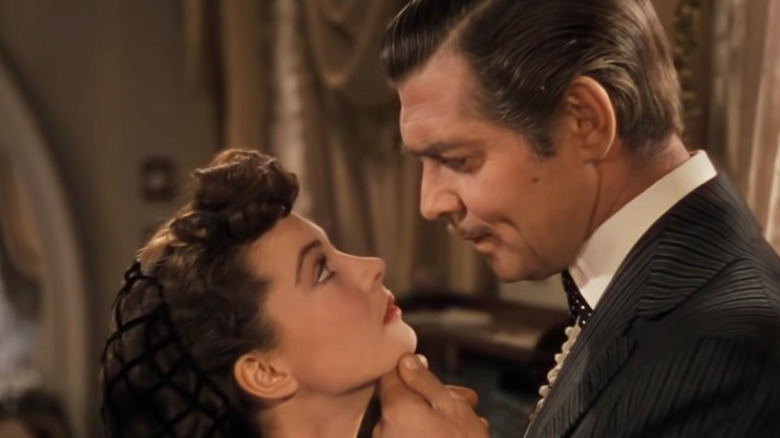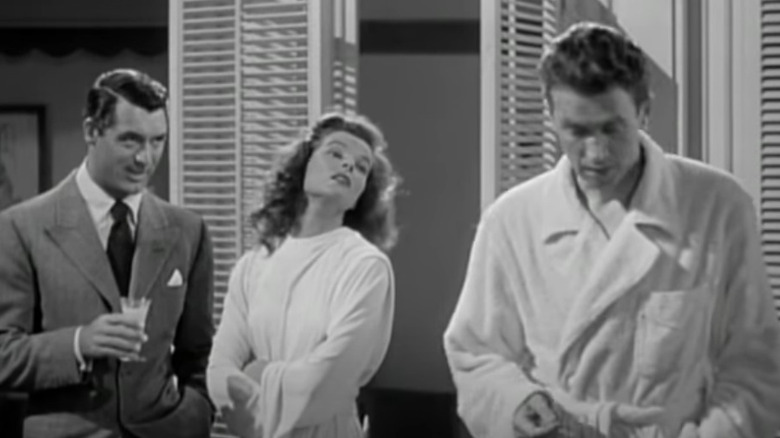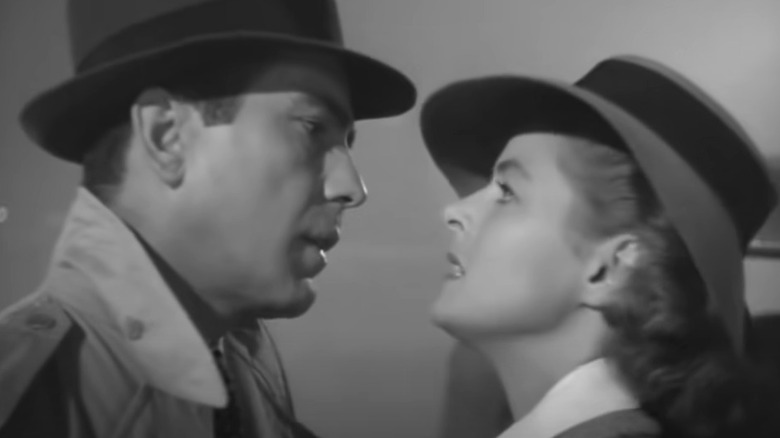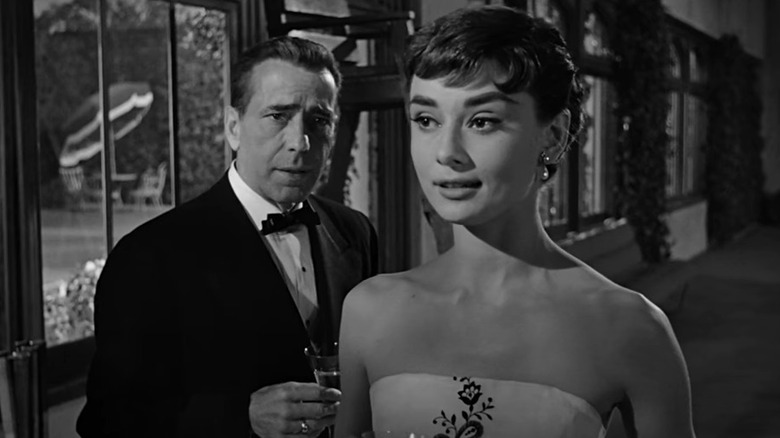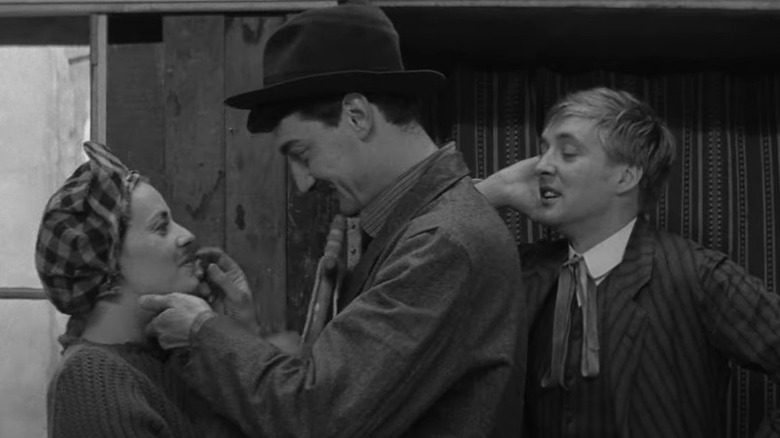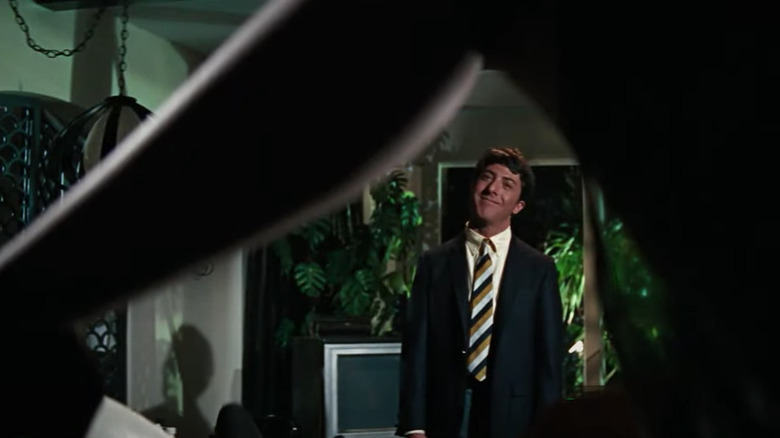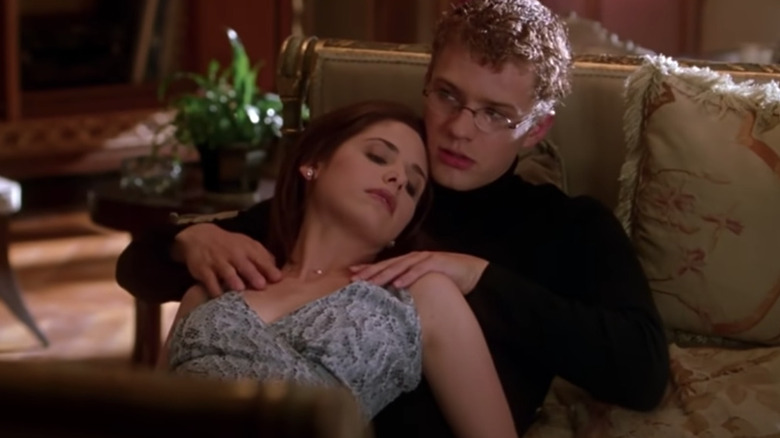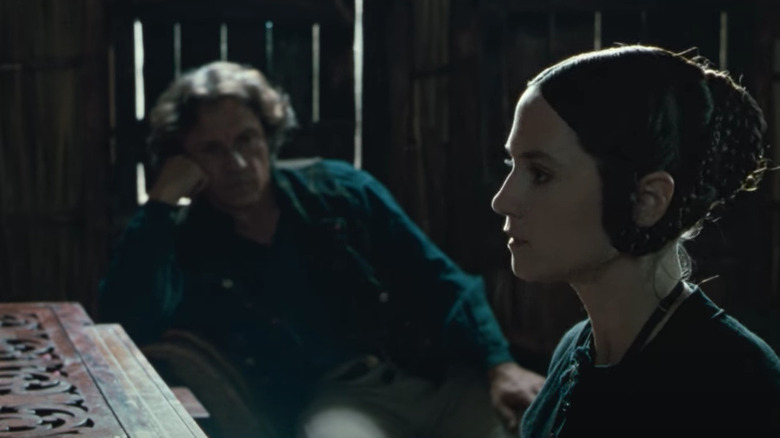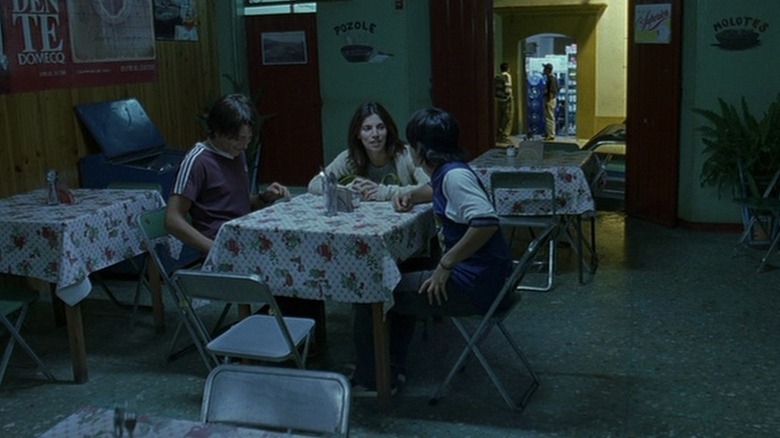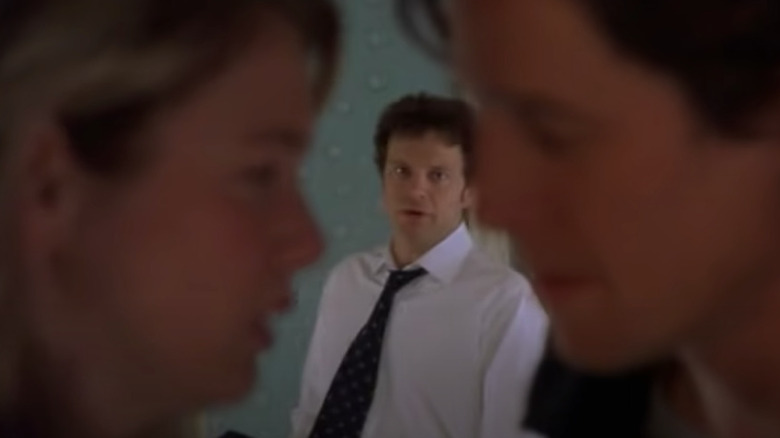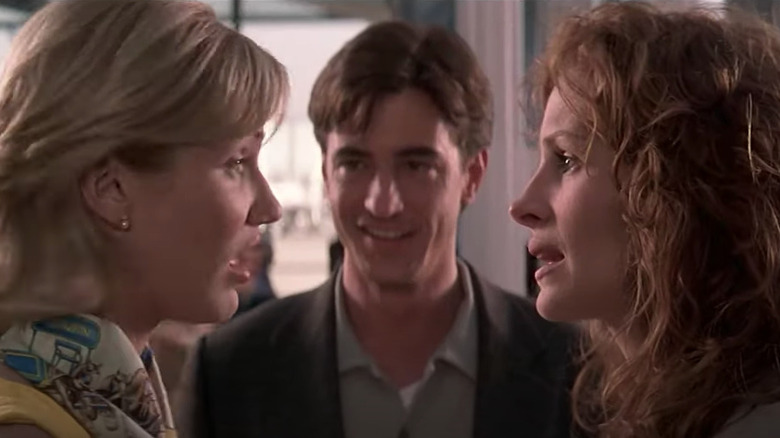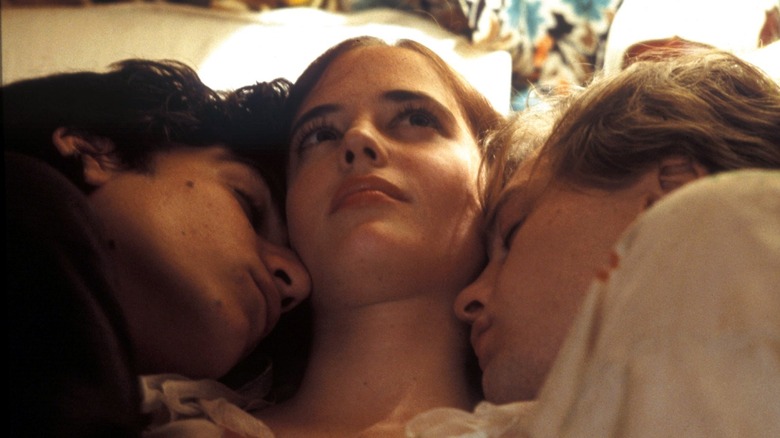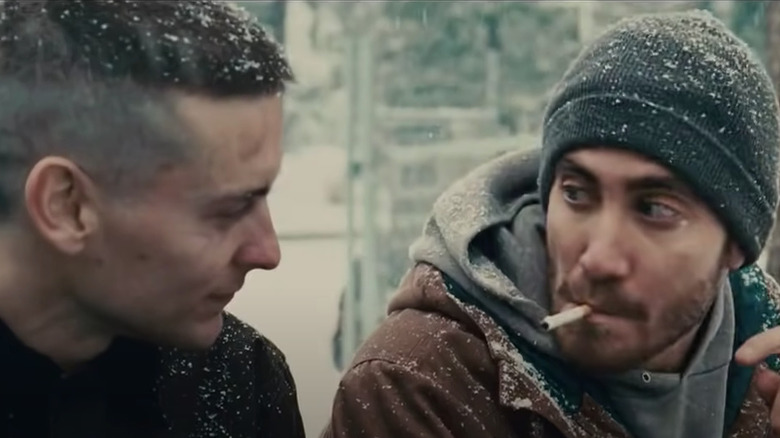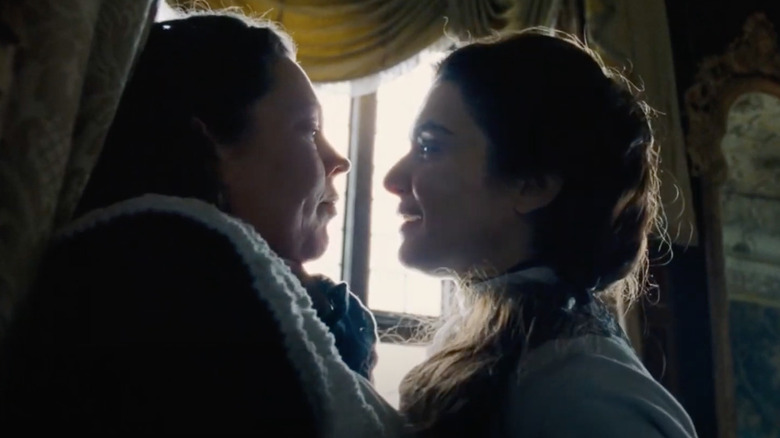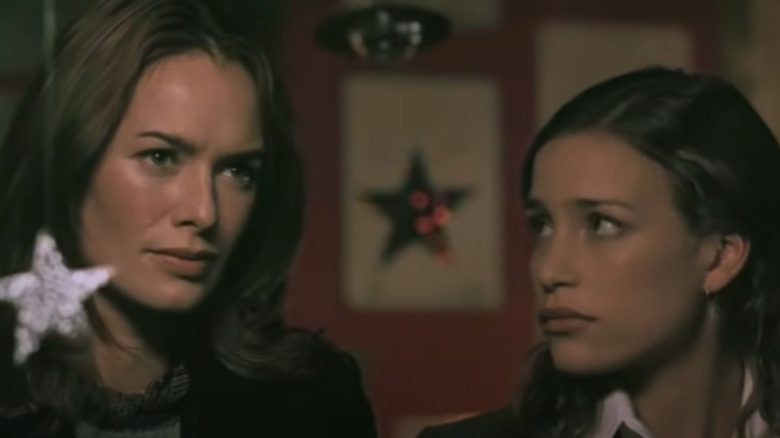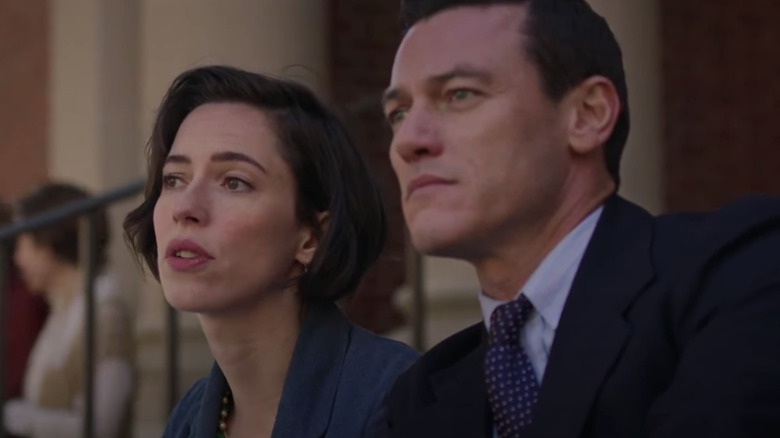The Best Love Triangles In Movies
Love triangles have been a favorite storytelling device throughout history: Greek mythology features many triangles (Dionysus, Ariadne, and Theseus or Oedipus and his parents, according to Freud) as well as squares, pentagons, and octagons (the Greeks got around). Shakespeare popularized triangles in "Romeo and Juliet" (with Romeo, Juliet, and Paris), and who would the Knights of the Round Table be without the triangulated drama of King Arthur, Guinevere, and Lancelot?
It's only natural that film would follow suit, which it did from the beginning. For many viewers, love triangles have proven to be as captivating and alluring — if not more so — than a two-person love story. After all, when adjusted for inflation, some of the highest-grossing movies of all time center around love triangles, including "Gone With the Wind," "Titanic," and "Doctor Zhivago." The power of love triangles is the tension as they combine envy, desire, and longing; they're often pulsating with anticipation as the relationship between looking and being looked at changes based on the subject. They can be sources of comedy and hijinks as much as sadness and drama, so read on to find out the best love triangles in film.
Gone With the Wind
Perhaps the most famous love triangle in film history is the oldest (on this list anyway), which continues to draw in viewers today. Victor Fleming's "Gone With the Wind" (based on Margaret Mitchell's book of the same name) was released in 1939 and remains the highest-grossing film of all time when adjusted for inflation. Audiences flocked to see the story of Scarlett O'Hara (Vivien Leigh), a Southern belle who loses it all during the Civil War as she goes from owning a cotton plantation to working in the fields with her family to survive. Scarlett is in love with the married Ashley (Leslie Howard), so instead she decides to wed Rhett Butler (Clark Gable), a cynical philanderer.
The love triangle of "Gone With the Wind" is based on a tried-and-true formula of one person stuck between two opposing sides. Rhett and Ashley are complete opposites: Rhett is dark-haired, full of dark energy, and a man who doesn't care much for the rules of the world or society while Ashley is a blonde-haired, often naive, indecisive gentleman. Although many aspects of "Gone With the Wind" are problematic and toxic –- its racism and glorification of slavery, to name a few — Scarlett O'Hara and her journey of self-discovery remain the beating heart of the film. This is what makes the love triangle with Rhett and Ashley feel alive even today as Scarlett's growing self-awareness moves her between the men as she discovers both her desires and needs.
The Philadelphia Story
George Cukor's "The Philadelphia Story" turned Katharine Hepburn from "box office poison" into a bona fide star and queen of the love triangle. Based on Philip Barry's 1939 play, the film follows Tracy (Hepburn), a socialite whose wedding hits a snag when her ex-husband Dex (Cary Grant) and a nosy tabloid reporter, Mike (Jimmy Stewart), both show up for the event. Tracy finds herself caught between two (well, really three) men who all represent something different: Dex is the past, Mike is the here and now present, and her fiance, George (John Howard) is the future.
While audiences were taken on the dizzying ride of the Katharine Hepburn-Cary Grant rollercoaster in 1938's "Bringing Up Baby," "The Philadelphia Story" gives these two greats a new type of dynamic and energy as Hepburn alternates between Grant and Stewart. Ultimately, she's the linchpin of the film as Tracy — an independent, fierce woman with a tightly-fashioned social mask –- becomes the focal point for the other characters. At one point, Tracy declares, "I don't want to be worshiped. I want to be loved," and this sentiment drives the film forward. Tracy is caught between men who look at her constantly but the question is, do they actually see her and who might they find under that mask? In Hepburn, Grant and Stewart's brilliant hands, the answer to this question becomes at once hilarious and heartbreaking, making this one of the best love triangles in film history.
Casablanca
Michael Curtiz's 1942 film "Casablanca" could have been very much a film of its time (the Second World War) but has instead transcended that to become timeless. This highly-quoted and beloved film centers around the relationship between Rick (Humphrey Bogart), an American living in Casablanca, and Ilsa (Ingrid Bergman). Once lovers in Paris after Ilsa thought that her husband, Victor (Paul Henreid), had been killed in a concentration camp, Victor's unexpected return transforms the line between Rick and Ilsa into a triangle. Ilsa is torn between the men she loves and must choose between staying with Rick in Casablanca or escaping with Victor to the United States.
The success of "Casablanca" can be attributed to its being a story of love and hope in the dark times of World War II. Rick and Ilsa both have to protect themselves from the painful forces of history; in fact, the war itself pulls these people apart even more than Victor's presence does since "the problems of three little people don't amount to a hill of beans in this crazy world." A love triangle activates both envy and desire: we covet what we can't have when we see our beloved with someone else and at the same time, we may be inspired by their love. Ultimately, Rick steps outside of his protective shell to choose his love for Ilsa, even if that means not choosing it for himself.
Sabrina (1954)
While for many, Audrey Hepburn has become an image of high class and elegance, some of her most famous characters are from a lower social echelon and make their way up, as seen in "Breakfast at Tiffany's" and "My Fair Lady." Such is the case with Sabrina Fairchild in Billy Wilder's "Sabrina," a film about a woman caught between two entitled brothers. Hepburn plays Sabrina, the daughter of the chauffeur of the wealthy Larrabee brothers, Linus (Humphrey Bogart) and David (William Holden). Playboy David has a thing for Sabrina, particularly after she goes off to Paris and returns a "changed" woman, but her working class status isn't desirable to Linus and David's father. So Linus is enlisted to keep Sabrina from David long enough for him to marry a woman of a more "acceptable" social standing, and a love triangle is born.
Billy Wilder, known for comedies like "Sunset Boulevard" and "Some Like It Hot," brings his magic touch to "Sabrina," a film filled with charm, wit, and commentary on class disparities. Of course, much of the magic lies in the power of Audrey Hepburn, who navigates this romance and the obstacles in her way as deftly and charmingly as only she can. While Sabrina initially only has eyes for David, she finds herself drawn towards the closed-off Linus; the two learn to open up together, which makes for one of the more delightful rom-com love triangles on the big screen.
Jules et Jim
In 1954, François Truffaut changed film history with the publication of his manifesto, "Une Certaine Tendance du Cinéma Français" ("A Certain Trend of French Cinema"), in the influential film magazine Cahiers du Cinéma. Truffaut lambasted French cinema and called for its deconstruction, which initiated the French New Wave movement. The French New Wave rejected the cinematic standards of sleek style and perfection: jump cuts and fragmented editing, long takes, and disconcerting or "unnatural" uses of diegetic and non-diegetic sound marked the French New Wave, of which Truffaut was a leader.
Truffaut's 1962 "Jules and Jim" takes the classic film standard of a love triangle and brings it into a French New Wave lens. The film follows the free-spirited Jim (Henri Serre), his introverted friend Jules (Oskar Werner) and the woman that they both love: the independent Catherine (Jeanne Moreau), who initially marries Jules. Catherine not only loves both men but in fact, the three of them live together as Jules realizes that he'd rather have both Catherine and Jim in his life than neither. The triangle isn't about two men competing nor is it about Catherine figuring out which is the better partner; it's about three people who get something different but equally important from one another, although somehow, they wind up not getting anything at all. Regardless, Truffaut treats this threesome relationship non-judgmentally and openly, which perhaps may be the most revolutionary aspect of this French New Wave classic.
The Graduate
Since its 1967 release, Mike Nichols' "The Graduate" has become a cultural touchstone, spawning endless spoofs, fantasies, and echoes of its often misquoted central question: "Mrs. Robinson, you're trying to seduce me. Aren't you?" The film tells the story of Benjamin Braddock (Dustin Hoffman in his breakout role), a lost 21-year-old college graduate who's searching for guidance. He finds it in the form of Mrs. Robinson (Anne Bancroft), who's married to his father's business partner and introduces Benjamin into the ways of the adult world. Things get complicated when Benjamin falls for Mrs. Robinson's daughter, Elaine (Katharine Ross), and finds himself torn between the two.
"The Graduate" was an immediate success, becoming the highest-grossing film worldwide of 1967. Dustin Hoffman became a star, millions still sing along to Simon and Garfunkel's "Mrs. Robinson," and it ushered in a new era of American filmmaking by combining the European arthouse style with a Hollywood commercial appeal. Benjamin marks a moment of transition in American history –- the shedding of the old to let in the new, as seen in the civil rights movement and sexual revolution –- and this is at the heart of his dilemma. Mrs. Robinson is from the past while Elaine represents the future. This is the choice that Benjamin must make, one that resonated with audiences across the board and continues to do so today.
Cruel Intentions
For many, the '90s was the heyday of peak teen cinema as movies like "Clueless," "Romeo and Juliet," and "10 Things I Hate About You" put modern spins on Jane Austen and Shakespeare. "Cruel Intentions" updated Pierre Choderlos de Laclos' "Dangerous Liaisons" and brought it into a New York private school setting. The film follows Sebastian (Ryan Phillippe), a bored, apathetic teen, whose scheming stepsister, Kathryn (Sarah Michelle Gellar), challenges him to seduce Annette (Reese Witherspoon), the headmistress' daughter who's vowed celibacy until marriage. If he doesn't succeed, he has to give Kathryn his vintage car but if he does, she'll let him sleep with her.
People may be shocked by the love triangle in "Cruel Intentions" as two of the parties are step-siblings, but this element just underscores the nature of this world on screen: Sebastian and Kathryn are both so entitled and isolated that they've become detached from the rest of the world. In fact, for them –- particularly for Kathryn -– the world is their playground, subject to their rules and secret games. "Cruel Intentions" works because Annette brings an outside perspective to Sebastian and Kathryn's world, which disrupts it and exposes the dysfunction and ultimately the loneliness that shapes it. It helps that the film stars a gaggle of iconic '90s teen stars: Selma Blair, Joshua Jackson, and Sean Patrick Thomas round out this film that made Reese Witherspoon a star and taught women –- nay, everyone –- everywhere how to properly kiss (on a blanket in the park).
The Piano
Jane Campion's 1993 classic "The Piano" is a 1880s period piece that focuses on Ada (Holly Hunter), a Scottish woman who's sold into marriage with Alisdair Stewart (Sam Neill), a violent New Zealand frontiersman. Mute for reasons that aren't even clear to her, Ada deploys her young daughter, Flora (Anna Paquin), as her interpreter as Ada communicates both with sign language and through playing the piano. Ada meets George Baines (Harvey Keitel), a free spirit who enlists her help in learning the piano. Ada gets caught between these two men, both of whom threaten her independence and sense of self in various ways, and struggles to hold onto herself and her piano in the wilderness of this new land.
"The Piano" launched Jane Campion to international recognition, as she became the first woman to win the Palme d'Or at Cannes and only the second woman in history to be nominated for a Best Director Oscar (and currently the only one to be nominated twice). The film stands out for its beauty, silence, and space as it brings viewers into Ada's world. It's not a world defined by the men in it; the more they try to take control, the more she has to find a space for herself between them, making this one of the more powerful love triangles on screen.
Y Tu Mamá También
Alfonso Cuarón's "Y Tu Mamá También" takes a classic genre — the buddy road trip –- and adds a sexy spin to it. The film follows two best friends, working class Julio (Gael García Bernal) and wealthy Tenoch (Diego Luna), who bridge their class divide via the teenage common interests of having intercourse and having fun. The boys find themselves on an unexpected adventure when Luisa (Maribel Verdú), a beautiful older woman, accepts their invitation to go on a road trip to the beach. Julio and Tenoch discover a world of maturity and pleasure in Luisa, while she finds a connection to life and youth itself in these obscene, playful, tight-knit young men.
"Y Tu Mamá También" was a star-making turn for real-life best friends Bernal and Luna as well as Cuarón, who wrote the film with his brother as a way of capturing that seemingly infinite potential of young male friendship that can actually be more ephemeral than not. The film shocked many with its graphic nature as Luisa has affairs with both men, both separately and then together, but it's not an exploitative look at a threesome. This is a movie about three people who are in a moment of transition, so they try to hold onto themselves and each other in a last-ditch effort to feel like everything is okay and will continue as it once was.
Bridget Jones's Diary
While love triangles certainly lend themselves to a dramatic space, they also fit right into the world of rom-coms as they can be a source of love, hijinks, and misunderstandings. Sharon Maguire's "Bridget Jones's Diary," based on Helen Fielding's novel of the same name (and loosely adapted from Jane Austen's "Pride and Prejudice"), centers around Bridget Jones (Renee Zellweger), who's either powerlessly chaotic or powerfully anti-establishment (regarding femininity at least), depending on who you ask. Bridget loves to drink and smoke and also struggles both with her weight and loneliness as she pines for her promiscuous and sexist boss, Daniel (Hugh Grant), while also developing feelings for the condescending but somewhat kinder Mark Darcy (Colin Firth).
"Bridget Jones's Diary" was a critical and commercial success, garnering an Oscar nomination for Zellweger and grossing $282 million worldwide on a $25 million budget. It spawned a franchise as viewers were anxious to see what, exactly, Bridget would be documenting in her diary about her funny, messy life. Daniel and Mark seem to be total opposites -– one is a careless playboy while the other is a seeming "nice guy" — but they're both cut from the same misogynistic cloth as neither initially sees Bridget as a "good enough" woman by their standards. Luckily, this is really Bridget's movie, and Zellweger infuses her with enough compassion and humor to navigate the chaos around her (which, to be fair, she often creates).
My Best Friend's Wedding
It was only a matter of time before rom-com queen Julia Roberts found herself in a love triangle, but surprisingly, she wound up in one that would challenge the conventions of the genre itself. P.J. Hogan's "My Best Friend's Wedding" follows Julianne a.k.a. Jules (Julia Roberts), a cynical food critic whose best friend and soulmate, Michael (Dermot Mulroney and thankfully, not Russell Crowe), is about to marry Kimmy (Cameron Diaz), a positive, bubbly young woman who is definitely not his soulmate. Or so Julianne thinks, as she sets out to break Michael and Kimmy up so that he realizes that she's the one he should be marrying instead.
If "My Best Friend's Wedding" were a classic rom-com, it would end with Jules getting to be with the man she loves, even after doing terrible things to make that happen. Instead, it's an unconventional tale that uses the star power of Julia Roberts to disrupt a genre and expose someone doing questionable things for her self-serving needs. It's hard to root for Jules and Michael as instead you get to see both Jules' flaws and Kimmy's attributes, which makes this a more complex triangle than what's usually on display. There's no clear winner here (other than Rupert Everett as George, Jules' gay best friend and platonic life partner) and this makes the love triangle of "My Best Friend's Wedding" one of the more memorable ones on screen.
The Dreamers
Bernardo Bertolucci's "The Dreamers" takes place in Paris in 1968 and follows Matthew (Michael Pitt), an American student who crashes at the apartment of bohemian twins, Théo (Louis Garrel) and Isabelle (Eva Green). Théo and Isabelle live in their own private world with secret games and languages, which they share with Matthew, who is surprised to find that the twins have few boundaries with each other. Matthew starts dating Isabelle, but gets caught in the politics of her and her brother and finds himself drawn to Théo as well. Their bubble gets burst with the return of Théo and Isabelle's parents, as well as the beginning of the Paris student protests, which ends their dream once and for all.
"The Dreamers" is classic Bertolucci in that it's both seductive and shocking. The film captures both the wistful beauty of a bygone time (in its dreamy cinematography and focus on the French New Wave films that bring the characters together) and the provocative nature of this homoerotic love triangle that perhaps speaks to the revolutionary spirit of the time in which rules only existed to be broken. While the love triangle of this film is between Matthew, Isabelle and Théo, there's another presence as well: "The Dreamers" incorporates clips and sounds from all the films that these characters love and integrate into their fantasy lives — which often blur into reality.
Brothers
Jim Sheridan's "Brothers" situates a love triangle in the original source of all drama: the family. The film focuses on Sam Cahill (Tobey Maguire), who's deployed to Afghanistan in 2007 and presumed to be killed in an attack. His wife, Grace (Natalie Portman), struggles to deal with her grief and adjust to life as a single mother, so his estranged and formerly imprisoned brother Tommy (Jake Gyllenhaal) tries to take care of Grace and help her with the kids. Sam actually hasn't been killed; instead, he's been captured as a POW and as he's rescued and makes his way home, he finds that things aren't as he once left them.
A remake of Susanne Bier's 2004 Danish film of the same name — with both inspired by Homer's "The Odyssey" — "Brothers" explores the pull that Grace feels between the two opposing forces of these brothers, while all three characters get caught in the rip tides of their grief. Perhaps one of the most poignant aspects of "The Odyssey" is the notion of returning to a home that almost looks the same but feels changed or slightly off. "Brothers" leans into this as all three characters try to hold onto what they once knew while allowing space for themselves and their lives to grow.
The Favourite
While Yorgos Lanthimos became known as an avant-garde director with films like "Dogtooth" and "The Lobster," his most commercial film, "The Favourite," takes a more classic storytelling approach with its focus on an 18th-century lesbian love triangle. At the center is Queen Anne (Olivia Colman), a sickly woman who is grieving the loss of her children. Sarah (Rachel Weisz) is the queen's secret paramour and also the secret driving force of political decisions, who finds herself suddenly in competition with her cousin, Abigail (Emma Stone), who also vies for Queen Anne's affections and favoritism. Both women need the queen for their own political gain and struggle to out-scheme and out-manipulate each other — and Anne — to maintain their power.
Politics certainly lends itself to the complex machinations of a love triangle and "The Favourite" makes use of that as it follows the various shifts of the relationships between Anne and Sarah, Anne and Abigail, and Abigail and Sarah. Underneath the political intrigue lie deeper emotions -– Sarah's bossiness and hard social mask belie her feelings and love for Anne, while Abigail's calculated steps cover her loneliness and real need as a woman trying to find some freedom and power in a world that offers her limited options. The love triangle resonated with audiences and critics as the film was nominated for 10 Oscars, garnered a win for Olivia Colman (who gave one of the best Oscar speeches ever), and made $96 million worldwide off a $15 million budget.
Imagine Me & You
Long before she found herself in a love triangle with her twin brother and Robert Baratheon, Lena Headey was in a threesome of somewhat less epic proportions in Ol Parker's 2005 indie film, "Imagine Me & You." The film follows Rachel (Piper Perabo), a woman who marries the kind and funny Heck (Matthew Goode) but suddenly finds this next phase of her life with her husband shaken up by the arrival of the charming Luce (Headey). Rachel first meets Luce on her own wedding day, as Luce is the florist for the event, and the two strike up a somewhat charged friendship. Luce is a lesbian, Rachel is married, and they both try to deny their feelings as Rachel attempts to protect her marriage and settle into the life she was supposed to live.
"Imagine Me & You" wasn't a box office or critical success but it stands out for its non-toxic and kind look at a lesbian relationship. Heck isn't a villain here and in fact, one can see how difficult it is for Rachel to feel the way she does as he's a good man who can offer her a good life, if that's what she wants. There's no rampant homophobia nor unnecessary lesbian tragedy of someone dying or deciding to stay with a man instead. That was a significant achievement in 2005 and remains so to this day, as there still aren't many positive representations of lesbian or bisexual couples or love triangles.
Professor Marston and the Wonder Women
Angela Robinson's "Professor Marston and the Wonder Women" is surprising for many reasons, not least of which is its positive portrayal of a healthy, polyamorous love triangle. Based on a true story, this 2017 film centers around the psychologist William Moulton Marston, who created Wonder Woman. As told in "Professor Marston and the Wonder Women," all of these inspirations came from the real life of Moulton (Luke Evans), who is married to Elizabeth (Rebecca Hall), also a psychologist and his colleague. The two of them start working with Olive (Bella Heathcote), a research assistant, and soon, both William and Elizabeth have fallen for Olive.
Robinson is an openly lesbian director whose earlier films like "D.E.B.S." explore queerness. In her hands, "Professor Marston and the Wonder Women" paints a picture of a love triangle that is open and willing to find a space that fits. Oftentimes, the tension of love triangles comes from the fact that a triangle cannot fit in the space between two people but William, Elizabeth, and Olive decide to find a new space instead. It's all the more surprising considering that they begin this relationship in the 1920s, it continues on until the 1980s, and in the end, all three characters choose themselves and each other.
